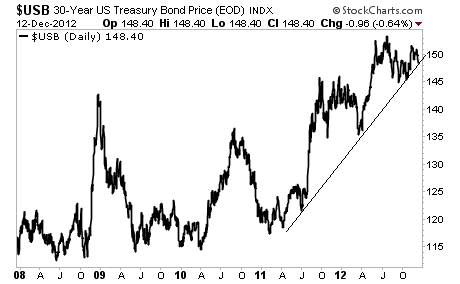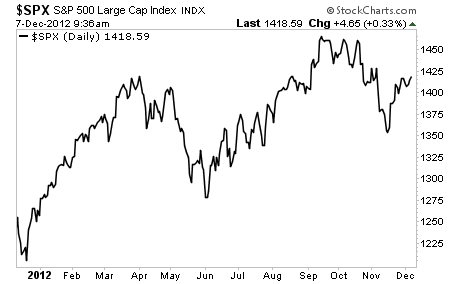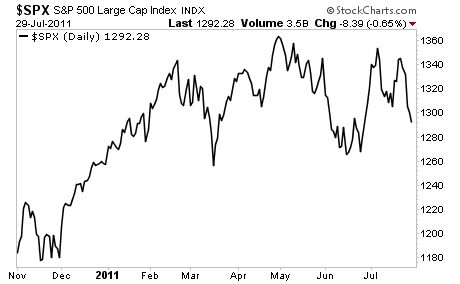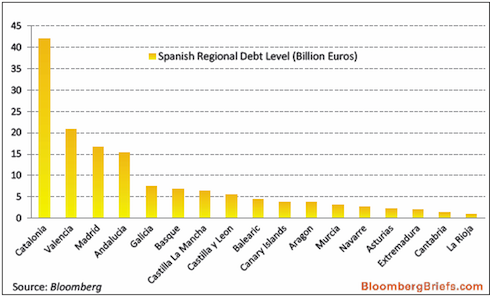Tonight between 7:30-9:30PM, the House will vote on Boehner’s “Plan B” for the fiscal cliff.
At this point the entire exercise is one of looking busy for appearance’s sake: it wouldn’t bode well if the US were to go over the fiscal cliff because members of Congress were already on vacation. So the political class needs to appear to be working on this problem even if no one is actually incentivized to come up with an actual solution.
My point is that the likelihood of an actual solution being presented and worked through at this point is less than 1%. The various plans that have been put on the table all propose items like reducing the deficit by $1 trillion over multiple years. This doesn’t really accomplish much when you consider that we’ve run a $1+ trillion deficit for four years now.
The fact remains, if we want to balance the budget, we need spending cuts and tax raises that add up to over $1 trillion. That’s simple math, but neither side of the political aisle is going to propose anything resembling this because it would be political suicide.
After all, what incentive is there to solve anything? US political leaders must have noticed that Greece, a country whose economy is only 2% that of the US’s, has managed to draw out its problems for over two years and the proposed “solutions” there remain as absurd as getting the country’s Debt to GDP levels down to 120% by 2022.
If this is what a country as small as Greece can get away with, why can’t the US, the single largest economy and owner of the world’s reserve currency draw out its fiscal problems far longer, must be the thinking process for Washington.
And why not? The US Federal Reserve has committed to fund the US’s bloated deficits. The Fed will buy 50% of new debt issuance next year. And interest rates will be kept at next to nothing for the foreseeable future.
There’s a reason for this: roughly half of the US’s debt outstanding matures in less than a year or so. Every point increase in interest rates means another $150 billion in interest payments. So Bernanke has to keep us at ZIRP forever.
This will “work” until it doesn’t. The problem is that when it doesn’t work anymore, the financial system will implode. Until then, there are little to no incentives for the political class to address the US’s financial problems. The Fed’s giving them a free lunch.
Unfortunately, these folks are ignoring the human toll Greece has had on its citizens. Today, 20% of Greek households are living below the poverty line. Five Greek children at hospitalized for malnutrition every week. This is the real cost of the crisis in Greece. And it’s the situation most analysis ignores.
Which is why the US is playing a dangerous game by hemming and hawing about the fiscal cliff: numbers wise the situation may not look apocalyptic, but with incomes down and the cost of living rising in the US, there will be a lot of suffering going forward.
So buckle up because we’re going over the cliff. And unlike the debt ceiling talks of 2011, the Fed is already pumping money into the system (in 2011, there was no official QE program in place when the debt ceiling talks took place).
If you’re an individual investor (not a day trader) looking for the means of profiting from all of this… particularly the US going over the fiscal cliff, then you NEED to check out my Private Wealth Advisory newsletter.
Indeed, 76 out of our last 90 trades have made money for Private Wealth Advisory subscribers. That’s an incredible 84% success rate on our investments.
And we’re not getting complacent by any means. In fact, I’m about to alert Private Wealth Advisory subscribers to several trades that will all produce HUGE profits when the US debt implosion picks up steam in the coming weeks.
You’ll find out what they are the minute you subscribe to Private Wealth Advisory. You’ll also gain immediate access to my Protect Your Family, Protect Your Savings, and Protect Your Portfolio Special Reports outlining how to prepare these areas of your life for the coming Great Crisis.
These reports outline:
1) how to prepare for bank holidays
2) which banks to avoid
3) how much bullion to own
4) how much cash is needed to get through systemic crises
5) how much food to stockpile, what kind to get, and where to get it
And more…
To take out an annual subscription to Private Wealth Advisory now… start profiting from the market’s gyrations (again we’ve made money on 76 out of 90 trades in the last 18 months)… and gain access to all my Special Reports…
Best Regards,
Graham Summers














